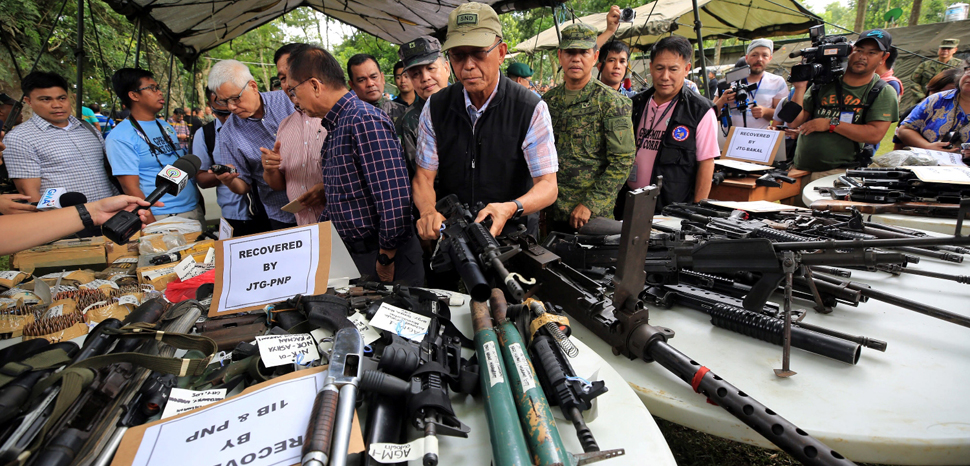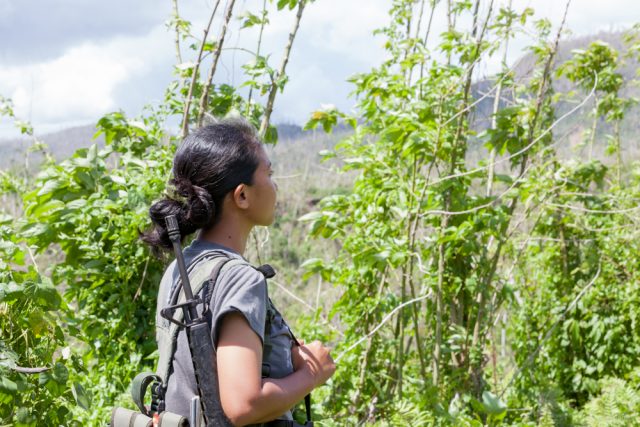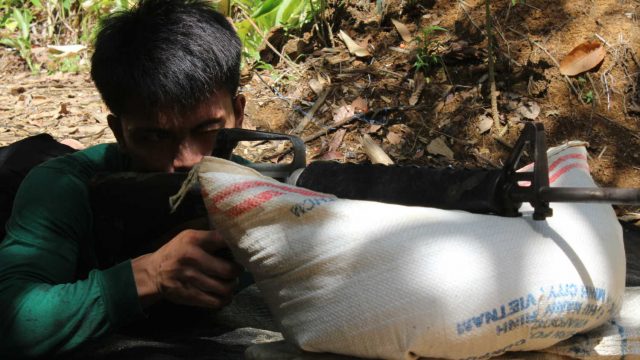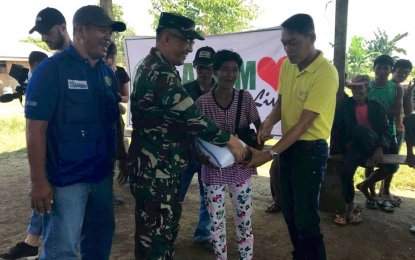From the Geopolitical Monitor (Feb 12):
Bangsamoro Islamic Freedom Fighters Assume ISIS’ Mantle in the Philippines’ Troubled South (By Michael Hart)
 Summary
SummaryIn the three months since the jihadists of the ISIS-linked Maute group were routed by Philippine troops in Marawi, another radical band of Islamists have risen from the shadows to take their place as the vanguard of
Islamic State in western Mindanao.
Since the five-month siege of Marawi ended in late-October, the Bangsamoro Islamic Freedom Fighters (BIFF) have launched a wave of IED attacks and regularly clashed with security forces, whilst their de-facto leader Esmael Abdulmalik has been touted as a possible replacement for slain Abu Sayyaf militant Isnilon Hapilon as ISIS’ new emir in Southeast Asia.In the post-Marawi climate of heightened threat awareness, the BIFF’s recent spike in activity has garnered an increasing amount of attention not only in the Philippines, but across the wider region as well. Yet the group has been around for almost a decade and has been involved in high-profile incidents before, notably the Mamasapano clash of January 2015 which left 44 Special Forces soldiers dead and sent shockwaves throughout the country. The BIFF has also claimed responsibility for bomb attacks in the past, whilst a small cohort of its fighters are thought to have taken part in last year’s
Marawi siege.
What underlies the BIFF’s intensified campaign of terror? And how has this previously little-known militant group emerged from being a mere footnote in Mindanao’s long-running armed Islamist insurgency to positioning itself as the last bastion of ISIS’ ambitions to carve out a regional caliphate? BackgroundThe BIFF has its roots in the decades-old Muslim separatist insurgency which has been fought on the Philippines’ conflict-plagued southern island of Mindanao since the early 1970s. In its initial stages, the insurgency was fought by the Moro National Liberation Front (MNLF) founded by Nur Misuari, and later by the Moro Islamic Liberation Front (MILF) founded by Hashim Salamat, which broke-off from the MNLF in 1981. Both organizations enjoyed support from large sections of the Muslim population in the Mindanao region, which has long suffered from underdevelopment and high rates of poverty in comparison to other parts of the majority-Catholic country, leaving its residents feeling marginalized.
The MNLF and the MILF both started out fighting for a fully-independent state for the Muslim-majority Moro population in the south, leading to a protracted conflict which has caused more than 100,000 deaths. Yet in recent decades their stance has softened as both groups have turned their attention away from armed struggle and toward peace talks with the government, aimed at securing greater autonomy in the south rather than independence. This shift angered hardline elements within the separatist movement, resulting in the formation of several radical groups to revive the campaign for a fully-independent Muslim state. A breakaway faction of the MNLF – Abu Sayyaf – emerged in 1990 and went on to gain global notoriety after launching a spate of kidnappings in the region and brutally beheading several Western hostages. Twenty years later, in 2010, a second splinter group emerged this time from within the ranks of the MILF, and called itself the Bangsamoro Islamic Freedom Fighters.
The BIFF was formed by Ameril Umbra Kato, who was educated in Saudi Arabia and espoused a more radical brand of Islam, one based on Salafi-Wahhabi ideology and practiced more widely in the Middle East than in Southeast Asia. Frustrated with the MILF’s decision to accept autonomy at the expense of full independence, Kato led around 300 former MILF comrades in a campaign of attacks targeting the military and civilians in rural areas across the provinces of Maguindanao and North Cotabato. The primary aim of the attacks was to disrupt the peace process between the government and the MILF.
Kato was succeeded as leader by Mohammad Ali Tambako after suffering a stroke in 2011, yet Tambako left to establish another militant group two years later. Kato died of natural causes in 2015 and the BIFF appointed Ismael Abubakar as its new figurehead, signalling a new era in which the group separated into factions and became more of a splintered guerrilla organization than a co-ordinated or hierarchical group. The BIFF remains loosely-structured today, and is not thought to have a defined leadership structure or central chain of command.
ImpactThe ISIS factor. Amidst uncertainty over its direction and leadership, the group pledged allegiance to Islamic State in late 2014. At the time, this was not viewed as a concern by the authorities and was seen as more of an attention-grabbing ploy aimed at aiding recruitment and boosting the group’s profile. This view changed suddenly in May last year, when militants from the ISIS-aligned Maute and Abu Sayyaf groups launched a brazen assault on the city of Marawi. The threat from ISIS had become visible, having materialized itself on a large scale in Southeast Asia for the first time. The Marawi crisis led the security forces in Mindanao to take pledges of allegiance to ISIS by smaller militant groups far more seriously.
The jihadists from the Maute group and Abu Sayyaf took five months to dislodge. In mid-October, the Philippine military announced the end of the siege after the deaths of militant leaders Omar Maute and Isnilon Hapilon in the main battle zone. More than 900 militants were killed in total, dealing a serious blow to Abu Sayyaf’s capabilities and virtually destroying the Maute group as a fighting force.
Whilst a small number of the BIFF’s members were thought to be present in Marawi, many of the group’s fighters remained in its heartlands elsewhere in western Mindanao. These BIFF fighters now constitute the surviving remnants of ISIS in the southern Philippines, and have taken up the mantle vacated by the Mautes with a renewed sense of purpose and authority.
Since the end of the Marawi siege, clashes between government forces and the BIFF have intensified in the provinces of Maguindanao and North Cotabato, where the group has its rural strongholds. Government airstrikes, ground offensives and gun battles resulted in the death of 28 BIFF members in the final three months of 2017, whilst two government troops were also killed
. In December, the BIFF launched a series of attacks targeting the indigenous Teduray tribe whilst attempting to seize pockets of territory in rural villages in Maguindanao province, setting fire to houses and killing several tribe members whilst driving thousands more from their homes. The BIFF has also launched a spate of bomb attacks targeting police patrols, military bases, and civilians. On New Year’s Eve, the militants detonated an IED outside a crowded bar in Tacurong city, killing two civilians and injuring twelve, having earlier in the day killed one and wounded five policemen in a bomb blast in Datu Hoffer town.
The BIFF remains split into at least three main factions, the largest and most active of which is led by Ismael Abdulmalik, also known by the alias Abu Turaife. In a particularly worrying development, the Armed Forces of the Philippines (AFP) has reported seeing ‘foreign-looking’ gunmen fighting alongside BIFF militants in Maguindanao province, indicating that terrorist fighters from elsewhere in Southeast Asia may have joined-up with the group. It is possible that surviving Maute group members, including a number of Indonesians and Malaysians believed to have fought in Marawi, may have bolstered the BIFF’s ranks. At present, the BIFF appears to be the new group of choice for the region’s militants.
Local authorities have said they are monitoring the recruitment activities of jihadist groups in western Mindanao and are bracing themselves for another Marawi-style attack. Cotabato city has been mentioned as a possible second target. President Duterte has responded by extending Martial Law in Mindanao until the end of 2018 and has promised to destroy the BIFF, whilst recently-installed military chief Lt. Gen. Rey Leonardo Guerrero has vowed to redeploy resources from Marawi to tackle Islamist groups across the south. Mindanao’s civilian population remains on edge as its security forces maintain a heightened state of alert, having conducted several urban warfare training exercises in recent months to prepare for a repeat of Marawi. The authorities do not want to be caught off-guard again like they were last May.
The BIFF poses a threat to Mindanao’s peace process. The rise to prominence of radical groups such as Maute, and now the BIFF, comes at a crucial stage in the southern Philippines’ drawn-out peace process with the MILF, which has laid down its weapons since a provisional peace deal with the government was signed in 2014.
Currently, lawmakers are debating the proposed Bangsamoro Basic Law (BBL) which would pave the way for a new autonomous region in the south to replace the existing Autonomous Region in Muslim Mindanao (ARMM), constituting a final negotiated end to hostilities with the largest groups in the Moro rebel movement.
The bill is expected to be passed later this year. Yet after slow progress in getting even to this stage, concerns have been voiced that
if the bill is delayed further, or in a worst-case scenario fails to pass through Congress, frustrations will grow and fertile ground for jihadist recruitment will be created. President Duterte and MILF chairman Al Haj Murad Ebrahim have both warned of the radicalization risk. Duterte has talked repeatedly of the importance of correcting ‘historical injustices’ committed to the Moro people, whilst Ebrahim has described the BBL as being of ‘great importance for stability and security in Southeast Asia’. In a November interview with Channel News Asia, the MILF leader said ‘the longer this process takes, the more people are going to be radicalized.’ Despite expressing his own frustration over the slow progress being made, Ebrahim has said the MILF remains firmly committed to the peace process and is staunchly opposed to radical groups such as the BIFF and Abu Sayyaf.
ForecastWhilst the passage of the BBL may be an important step in quelling the long-running insurgency, it must be noted that previous peace agreements have not succeeded in ending the violence altogether. Despite the creation of the ARMM in 1989 and the signing of separate peace accords with the MNLF in 1996 and the MILF in 2014, several new groups have been spawned and the insurgency has evolved.
At present, it is the BIFF which pose the greatest concern going forward. Radical groups such as the BIFF will remain attractive to those who will never accept autonomy and maintain a desire to see a fully-independent
Islamic state created in the southern Philippines. This is especially true for those living in the most impoverished areas of Mindanao, who may feel disenfranchised and excluded from the potential benefits that any political settlement may bring.
As long as the underlying conditions of instability remain present in Mindanao, transnational terror groups such as ISIS and aspiring militants from across the region will seek to take advantage of the situation. These links pose the biggest challenge to the ongoing peace process in the Philippines’ troubled south. Despite efforts on both sides to secure a lasting peace, the spread of ISIS’ global ideology to the region continues to aid recruitment, giving new meaning and impetus to the localized battles fought by formerly little-known militant groups such as the Mautes, Abu Sayyaf and now the Bangsamoro Islamic Freedom Fighters.
https://www.geopoliticalmonitor.com/bangsamoro-islamic-freedom-fighters-assume-isis-mantle-in-the-philippines-troubled-south/

















